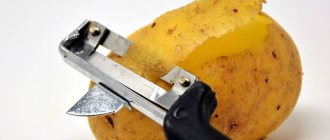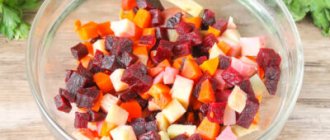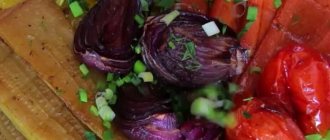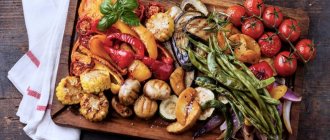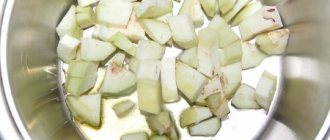In October, there are not so many seasonal vegetables on the table, and you want to preserve their benefits longer. Our great-great-grandmothers knew how to do this. Pickling, the oldest method of preserving vegetables and fruits, which is now called the fashionable word “fermentation,” is again at the peak of popularity. The healthy lifestyle community is buzzing about the new superfood, and nutritionists are vying with each other to talk about the benefits of fermentation. Let's tell you what fermented vegetables are, how they are useful and how to prepare them at home.
Katerina Kudertseva, blogger 10/11/2019
Basic Fermented Vegetable Recipe
Yield: approximately 1 liter jar
The recipe uses 1 am unit. glass – 236 ml.
Ingredients:
- 2 -3 cups chopped vegetables
- Brine for pouring (1 liter of boiled filtered water, 2 tablespoons of sea salt or coarse rock salt for salting)
- Spices to taste (peppercorns, cumin, garlic, etc.), optional
Preparation:
- Prepare a brine from boiled water and salt. Set aside to cool.
- Transfer the vegetables into a clean (can be sterilized) jar, alternating them with spices.
- Pour in the brine until all the vegetables are covered. Using a spoon or pestle, press down gently to allow air bubbles to escape. You can place a load on top (for example, place a saucer with a bag of cereal or dried beans).
- Cover with a clean cloth or a light lid and leave to ferment at room temperature (18 - 25 degrees C) away from direct sunlight.
- After 3 – 14 days (depending on the desired taste), close the jar with a lid and store it in a cool place. The longer the fermentation process, the more lactobacteria the finished product contains.
WHAT IS FERMENTATION?
When many people hear the word “fermentation,” they imagine a complex, high-tech process. However, this technology is not new, and we have known products obtained through fermentation since childhood. These are sauerkraut and apples, pickles, kombucha or, as it is now called, kombucha, kefir, pu-erh tea, cheese, apple cider vinegar, chutney, etc. Fermentation is the oldest technology for preserving food, and the first experiences of its use are associated with the history of brewing, which dates back to the Neolithic era.
Essentially, fermentation is a fermentation process in which microorganisms or their enzymes break down organic substances in the absence of oxygen. This process occurs differently for different products. For example, fermentation of vegetables is associated with the activity of lactic acid microorganisms, and fermentation of meat or fish is caused by the activity of its own enzymes. Just like tea fermentation, the process of oxidation of catechins contained in leaves with the participation of oxidase enzymes is most often called. In this case, pu-erh is an exception, because Microorganisms are involved in its production.
Depending on the product that is being fermented, this process is called differently. For vegetables and fruits, this is the well-known fermentation, salting and soaking.
Pickled beets
The process is longer than fermenting cabbage, but worth it.
Yield: approximately 1 liter jar or 2 half-liter jars
Source
Ingredients:
- 500 g beets (4 -5 medium size)
- 1 ½ tsp. cumin seeds
- 1 tsp coarse or kosher salt
- 2 cups boiled cooled water
- ¼ cup whole basil leaves (or other herbs, optional)
Preparation:
- Cut the peeled beets into thin slices (no thicker than 5 mm).
- Place cumin seeds in the bottom of clean fermentation jars and chopped beet slices on top.
- Prepare brine by dissolving salt in water. Pour over the beets until it just covers the beets. If necessary, you can add clean boiled water.
- Place a weight on top so that it fits inside your jar, and all the beets remain covered with liquid. Cover everything on top with a clean cloth.
- Place the jar(s) on a small plate or tray and leave to ferment at room temperature (18 – 25 degrees C) for 7-14 days.
- As fermentation proceeds, a noticeable increase in gas formation will be felt. When the desired taste and spiciness is achieved, remove the weight, close the jar(s) and put it in the refrigerator. If you put in greens, throw them away after a couple of days. Store in the refrigerator for up to 3-4 months.
Your stomach actually protects you from infections
A recent article in Scientific American 1 explores an alternative explanation for how your stomach works. The "sieve hypothesis" suggests that your stomach may act as a sieve or filter, preventing some of the most harmful microbes from entering your small intestine. The evidence for this is not new. It comes from a 1948 study conducted by Dr. Orla-Jensen, a former professor at the Royal Danish Technical College, a study that has essentially been “lost” in the literature for over 60 years.
The professor argued that your stomach uses acid to destroy pathogenic disease-causing bacteria, fungi, viruses, worms and protozoa, while allowing more beneficial microbes (which are acid resistant) to pass through. If your stomach fails to kill these pathogens, they can dominate your intestines, damaging and destroying the intestinal wall and causing disease.
Your stomach usually becomes less acidic as you age, especially after age 70. In his study, Orla-Jensen compared the gut bacteria of young people with the gut bacteria of healthy older people, as well as older people with dementia. He found that as people age, the proportion of pathogenic microbes in their intestinal tract increases compared to beneficial microbes. This was particularly pronounced in older people with dementia... raising the question of whether dementia can actually be caused by a "gut infection".
Currently reading: Kimchi: a food that helps get rid of pesticides
A study from the University of California, Davis found that E. coli and Salmonella bacteria in mice formed fiber-like structures very similar to the inflammatory brain plaques seen in people with Alzheimer's disease 2 . Your brain is formed by bacteria in your digestive tract. Bacteria in the gut actually control the expression of certain genes in brain cells. 3 Other studies have reported that disrupted gut flora in older adults contributes to accelerated aging, frailty, and premature death.
More research is needed to understand the precise relationship between dysbiosis and dementia. But at the very least, these studies highlight the importance of maintaining high levels of good bacteria in your gut. In fact, this bacterial community may be responsible for your entire metabolism.
Cabbage, pickled with apples and ginger
Yield 1.5 liters
Source rawfoodchef.com
Ingredients:
- 1 medium cabbage, finely shredded or shredded in food processor
- Cabbage leaves for topping
- 2 sour apples
- 1 tsp ginger, grated
- 1 tsp Himalayan salt
Preparation:
- Place the cabbage in a bowl, sprinkle with salt and rub with your hands until enough juice is released.
- Add all other ingredients and mix well.
- Pack the cabbage tightly into a clean glass or ceramic bowl. Cover the top with cabbage leaves, so that they extend beyond the edges of the dish, and there is access to air. Place a saucer with a load on top (a bag of cereal or dried beans). Cover with a clean cloth and place in a dark place to ferment for 3-4 days at room temperature. Transfer the finished cabbage to a glass jar and store in the refrigerator. It is more beneficial to consume it in the first weeks, when it contains more lactobacteria.
Benefits of Fermented Foods
The key benefit of fermented foods is their ability to replenish the gut with the “right” bacteria. Fermented foods improve digestion, especially if you start eating with them, and relieve heartburn and constipation.
This is the best support for the immune system: even a small portion of sauerkraut or other food made from fermented foods enriches the body with B vitamins, omega-3 fatty acids, digestive enzymes - all of which inhibit inflammatory processes and aging of the body.
The amount of enzymes and probiotics needed to keep us healthy and youthful has declined sharply in the human diet over the past fifty years. Fermented foods, naturally rich in these essential substances for us, help fill the gap.
One of the powerful benefits of fermented foods is that they “teach” the stomach to maximally absorb the necessary vitamins, minerals and other beneficial substances from the incoming food. Serotonin, a hormone on which our well-being depends and which regulates cravings for sweets, is produced in the intestines.
Thus, healthy microflora guarantees not only good digestion, but also a good mood and harmony. Unlike most superfoods, fermented foods are incredibly cheap. This is important if you are going through a difficult money period.
Sauerkraut with beets
Yield: approximately 3 cups
Source
Ingredients:
- 3 cups shredded cabbage
- 1 cup grated beets
- ⅛-¼ cup chopped onion (optional, optional)
- 1 tsp coarse salt + additional brine as needed
- Additional spices upon request
- 1 tsp cumin
- 1 tsp grated ginger
- 1 clove garlic, finely chopped
- 1 whole cabbage leaf
Preparation:
- Place shredded cabbage and grated beets in a mixing bowl. There should be about 4 cups in total. Add chopped onion.
- Add salt and rub the mixture well with your hands. Leave for 1 - 2 hours until the cabbage softens and releases juice.
- Transfer the vegetable mixture along with the resulting juice into a thoroughly washed fermentation jar. Press down well with a wooden pestle or non-metallic spoon. Place a cabbage leaf on top and compact again. Cover the jar with a clean cloth or cover it with a lid so that there is access to air.
- Leave to ferment for 24 hours, pressing the cabbage occasionally. After 24 hours, if the liquid in the jar does not cover all the cabbage, then add brine to the desired level. (For brine, boil water in advance. Dissolve 1 teaspoon of salt in 1 glass of cooled boiled water with 1 teaspoon of salt).
- Leave to ferment at room temperature for another 3-4 days, depending on the room temperature. Apply pressure or periodically press on the cabbage to allow the resulting gases to escape. The fermentation process is accompanied by natural gas formation, so there is no need to be afraid of the smell.
- At the end of 4 days, close the lid tightly and put it in the refrigerator for storage. After cooling, both the smell and taste improve.
Harm from fermented foods
Fermented foods not only provide benefits, but can also cause some side effects. The most common negative reaction is bloating and increased gas. Most often, these symptoms appear after eating foods rich in fiber (kimchi, sauerkraut).
It is also known that fermented dairy products are most often fruit and flavored yogurts with a lot of sugar, which are unlikely to provide you with the desired benefits.
Those who suffer from peptic ulcers or high stomach acidity should completely refrain from consuming fermented foods. If you often experience flatulence or have histamine intolerance, you should add fermented foods to your diet very carefully, monitoring the body’s reaction.
Korean pickled vegetables
Source
Ingredients:
- 1 cup chopped carrots
- 1 cup cauliflower florets
- 1 cup shredded Chinese cabbage
- 1 cup shredded red cabbage
- 3 green onions, chopped
- ginger root (about 2.5cm), peeled and NOT finely chopped
- 2 cloves garlic
- 2 ½ tsp. salt
- ¼ tsp. hot pepper (optional)
Preparation:
- Place carrots and all types of cabbage in a bowl, sprinkle with salt and stir. Let stand for half an hour.
- Rinse with cold water and drain in a colander. Mix with remaining ingredients.
- Place in a storage jar, cover tightly with a lid and refrigerate for 2 days.
- On the third day, remove the garlic and ginger from the mixture. You can serve!
Carrot snack with ginger
Source
Ingredients:
- 1–1 ½ kg carrots, cut into circles
- 100-120 g cabbage, shredded
- 1 -2 tbsp. onion, grated
- ¾ cup fresh ginger, grated or dried to taste
- Water
- 1 tbsp. salt
Preparation:
- Dissolve salt in cooled boiled water and add ginger. Mix.
- Mix prepared carrots, cabbage and onions in a bowl. Transfer to a clean fermentation container.
- Pour the prepared brine over the vegetables. Add more water if the vegetables are not completely covered.
- Leave to ferment at room temperature for 3 to 14 days, covering the top with a clean cloth. Once the desired taste and spiciness are achieved, transfer to a storage container and store in a cool place (cellar or refrigerator).
Fermented Green Beans
This wonderful appetizer is great without vinegar. Due to the preservation of its own enzymes and vitamins, it can be stored for at least a month.
Yield: 2 liter jars
Source
Ingredients:
- 2 liters of water
- 4-6 tbsp. sea salt
- 500 g young green beans
- 2 tbsp. hot pepper or to taste
- 4 cloves garlic, peeled and crushed
- 1 tsp peppercorns
- 2 handfuls of dill, preferably brooms (umbrellas), but you can also use greens
Preparation:
- Prepare brine by dissolving salt in water. Prepare the container.
- Place pepper, garlic and dill into both jars.
- Place the green beans on top - vertically if they are thin and long, or across the ones that are thicker and sliced. Pour in brine, not bringing it to the top of the jar by about 2-3 cm.
- Close with a lid or cover with a cloth on top. Leave to ferment until desired texture and flavor are achieved (at room temperature 17 – 23 degrees away from sunlight). If you close the lid, open it periodically to relieve the pressure inside.
- A few days after fermentation is complete, close the jars with lids and put them in a cool place.
What is fermentation?
This is the process of fermenting food in liquid without air. In the process, beneficial microorganisms are formed, for which an anaerobic environment is important. It does not require oxygen, and sometimes it is even harmful to bacteria and can contribute to their death.
What are the benefits of fermented foods?
- This way you can prepare vegetables, fruits, milk, meat, fish and even drinks. Pickling has been popular since ancient times. It is very useful for the functioning of the gastrointestinal tract and the state of our immunity.
- Wise housewives begin a large-scale “project” of preparations for the cold in the summer, among which fermented vegetables and other fruits occupy not the least place.
- During the fermentation process, under anaerobic conditions, solid components are separated from the liquid. The result is a healthy brine that can be used for home baking.
- The fruits themselves, very tasty and valuable, are very popular among adults and children. They contain a very high percentage of vitamin C and other important substances for the health of the body. Natural enzymes and vitamins are not destroyed in this food.
Important: to avoid harm to your body, start consuming fermented foods only in small quantities, and then gradually increase the dose.
Where to begin?
Prepare thoroughly before your planned event.
- Prepare vegetables, fruits (completely whole, without damage or rotten areas), maybe sourdough. It is important to stock up on coarse salt (although there are recipes without it if you prefer to use as little as possible). Alternatively, use Himalayan pink.
- There are fermenters specially produced by industry. These include, for example, a yogurt maker or a bread fermenter. Every little detail is thought through in the device, including temperature conditions and pressure creation, as well as holes for air outlet.
- Choosing a container is important, because products can be stored there for a long time, and harmful substances should not get into the liquid. Professionals recommend choosing ceramics or glass.
- If you do not use industrial equipment, but decide to ferment vegetables the old fashioned way, then find a form of pressure: a heavy container, some kind of weight to press the vegetables.



